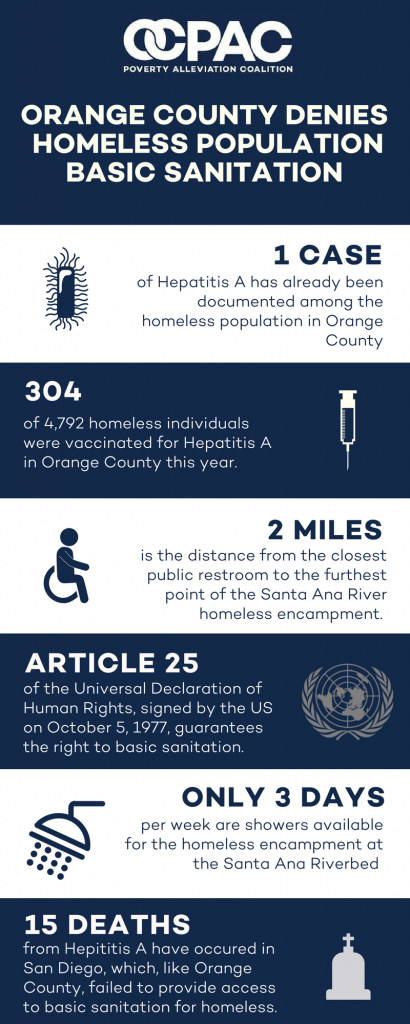
Infographic from Orange County Poverty Alleviation Coalition
(
For updates, see comments at end)
San Diego County reports Hepatitis A is the cause of death of 16 people, 14 of which were unhoused citizens living in the city’s East Village. Today
444 San Diegans are infected, more than the 2015 total for the states of California, New York and Texas combined. Los Angeles County, many of whose
57,000 homeless residents live downtown in tents and temporary shelters, is struggling to
contain their own outbreak.
Between San Diego and Los Angeles lies Orange County, where portable toilets were removed from along the Santa Ana river in a counter-productive attempt to encourage people camping nearby to move on. In response to the
open letter that PHLUSH sent to the Board of Supervisors, the County tweeted that they had “extended the hours of a restroom along the flood control channel at Katella to make them available for 24/7 use.” Later we learned that this facility is two miles from where most homeless people live.
Activists engage and victims are blamed.
On September 20, Mohammed Aly , the young lawyer who heads the
Orange County Poverty Alleviation Coalition was arrested while taking measures to improve hygiene in a homeless community. After supporters helped pay his $20,000 bail, he released this statement. “I was arrested yesterday and charged with a felony for using bleach and a hand pump to disinfect and drain a fetid swamp inside of the Santa Ana Riverbed homeless encampment. That polluted water accumulated because the largest homeless encampment in the county still lacks regular access to hygiene and basic sanitation.”
In San Diego, Father Joe’s, a human services nonprofit under contract with the city to provide toilets for the homeless has faced criticism for their lack of cleanliness. Executive Director Jim Vargas says that portapotties have long been
cleaned every two hours but that following closures elsewhere there are simply not enough toilets downtown.
Meanwhile a
Fox News headline screams. “San Diego begins ‘sanitary street washing’ of downtown after pooping homeless people cause deadly hepatitis outbreak.” That the homeless victims of this outbreak are perceived as the “other” is echoed in
Hep A avoidance guidelines from San Diego County Public Health’s Dr. Wilma Wooten, who “recommends people remove their shoes before entering their homes.”
Officials scramble with handwashing stations, street bleaching and vaccination campaigns.
The US Centers for Disease Control state unequivocally that Hep A “is spread from person to person through contact with the feces (stool) of people who are infected, which can easily happen if someone does not wash his or her hands properly.” As hand sanitizer is not considered effective against Hepatitis A, the city of San Diego has quickly deployed
40 portable handwashing stations. On the website of
LA County Public Health, however, basic fecal-oral transmission is hardly mentioned and handwashing with soap is almost an afterthought. Instead the focus is on illicit drugs needle sharing, sex, and eating contaminated food.
Los Angeles’ deployment of multi unit restroom facilities is constrained by a lack of appropriate public space, causing the LA Times Editorial Board to recommend that
“Anyone who has a parking lot to offer should call the city.” While San Diego restroom availability has expanded considerably thanks to longer hours, the placement of portable units and better signage, the
East Village remains underserved.
All three Southern California counties are undertaking vaccination campaigns among vulnerable communities. San Diego clinics and health outreach workers have administered
more than 22,000 vaccinations so far.
Public restrooms and the lessons of too little too late.
Writing in the San Diego Union-Tribune,
investigative reporter James DeHaven shows that local officials had been warned of the public health consequences of two few available public restrooms. Since the year 2000, the City of San Diego’s 19-member civic watchdog panel has released four grand jury reports. “Each of the reports called on the city to either add more all-hours, publicly available restrooms or bolster its street cleaning regimen to ensure the public would not be exposed to human waste,” writes DeHaven. (Note the irony of clearing the right-of-way of poop rather than providing restrooms that would send it directly to the sewer. ) The City’s response to the grand jury reports? New restrooms attract crime and cost too much. As for help from private developers, city officials note that they, too, are not eager to be associated with restrooms.

